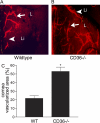Thrombospondin 1 inhibits inflammatory lymphangiogenesis by CD36 ligation on monocytes
- PMID: 21536744
- PMCID: PMC3092349
- DOI: 10.1084/jem.20092277
Thrombospondin 1 inhibits inflammatory lymphangiogenesis by CD36 ligation on monocytes
Abstract
Lymphangiogenesis plays an important role in tumor metastasis and transplant outcome. Here, we show that thrombospondin-1 (TSP-1), a multifunctional extracellular matrix protein and naturally occurring inhibitor of angiogenesis inhibits lymphangiogenesis in mice. Compared with wild-type mice, 6-mo-old TSP-1-deficient mice develop increased spontaneous corneal lymphangiogenesis. Similarly, in a model of inflammation-induced corneal neovascularization, young TSP-1-deficient mice develop exacerbated lymphangiogenesis, which can be reversed by topical application of recombinant human TSP-1. Such increased corneal lymphangiogenesis is also detected in mice lacking CD36, a receptor for TSP-1. In these mice, repopulation of corneal macrophages with predominantly WT mice via bone marrow reconstitution ameliorates their prolymphangiogenic phenotype. In vitro, exposure of WT macrophages to TSP-1 suppresses expression of lymphangiogenic factors vascular endothelial growth factor (VEGF)-C and VEGF-D, but not of a primarily hemangiogenic factor VEGF-A. Inhibition of VEGF-C is not detected in the absence or blockade of CD36. These findings suggest that TSP-1, by ligating CD36 on monocytic cells, acts as an endogenous inhibitor of lymphangiogenesis.
Figures






Similar articles
-
VEGF-A expression by HSV-1-infected cells drives corneal lymphangiogenesis.J Exp Med. 2010 Jan 18;207(1):101-15. doi: 10.1084/jem.20091385. Epub 2009 Dec 21. J Exp Med. 2010. PMID: 20026662 Free PMC article.
-
The maintenance of lymphatic vessels in the cornea is dependent on the presence of macrophages.Invest Ophthalmol Vis Sci. 2012 May 31;53(6):3145-53. doi: 10.1167/iovs.11-8010. Invest Ophthalmol Vis Sci. 2012. PMID: 22511631
-
Capillary sprout endothelial cells exhibit a CD36 low phenotype: regulation by shear stress and vascular endothelial growth factor-induced mechanism for attenuating anti-proliferative thrombospondin-1 signaling.Am J Pathol. 2008 Oct;173(4):1220-8. doi: 10.2353/ajpath.2008.071194. Epub 2008 Sep 4. Am J Pathol. 2008. PMID: 18772338 Free PMC article.
-
Lymphangiogenesis Guidance Mechanisms and Therapeutic Implications in Pathological States of the Cornea.Cells. 2023 Jan 14;12(2):319. doi: 10.3390/cells12020319. Cells. 2023. PMID: 36672254 Free PMC article. Review.
-
Macrophage-Mediated Tissue Vascularization: Similarities and Differences Between Cornea and Skin.Front Immunol. 2021 Apr 7;12:667830. doi: 10.3389/fimmu.2021.667830. eCollection 2021. Front Immunol. 2021. PMID: 33897716 Free PMC article. Review.
Cited by
-
Involvement of corneal lymphangiogenesis in a mouse model of allergic eye disease.Invest Ophthalmol Vis Sci. 2015 May;56(5):3140-8. doi: 10.1167/iovs.14-16186. Invest Ophthalmol Vis Sci. 2015. PMID: 26024097 Free PMC article.
-
PEDF inhibits lymphatic metastasis of nasopharyngeal carcinoma as a new lymphangiogenesis inhibitor.Cell Death Dis. 2021 Mar 17;12(4):295. doi: 10.1038/s41419-021-03583-1. Cell Death Dis. 2021. PMID: 33731707 Free PMC article.
-
Thrombospondin 1 missense alleles induce extracellular matrix protein aggregation and TM dysfunction in congenital glaucoma.J Clin Invest. 2022 Dec 1;132(23):e156967. doi: 10.1172/JCI156967. J Clin Invest. 2022. PMID: 36453543 Free PMC article.
-
Effect of Hypoxia Preconditioned Secretomes on Lymphangiogenic and Angiogenic Sprouting: An in Vitro Analysis.Biomedicines. 2020 Sep 20;8(9):365. doi: 10.3390/biomedicines8090365. Biomedicines. 2020. PMID: 32962277 Free PMC article.
-
The immunoregulatory role of corneal epithelium-derived thrombospondin-1 in dry eye disease.Ocul Surf. 2018 Oct;16(4):470-477. doi: 10.1016/j.jtos.2018.07.005. Epub 2018 Jul 25. Ocul Surf. 2018. PMID: 30055331 Free PMC article.
References
-
- Albuquerque R.J., Hayashi T., Cho W.G., Kleinman M.E., Dridi S., Takeda A., Baffi J.Z., Yamada K., Kaneko H., Green M.G., et al. 2009. Alternatively spliced vascular endothelial growth factor receptor-2 is an essential endogenous inhibitor of lymphatic vessel growth. Nat. Med. 15:993–994 10.1038/nm.2018 - DOI - PMC - PubMed
Publication types
MeSH terms
Substances
Grants and funding
LinkOut - more resources
Full Text Sources
Other Literature Sources
Molecular Biology Databases
Miscellaneous

